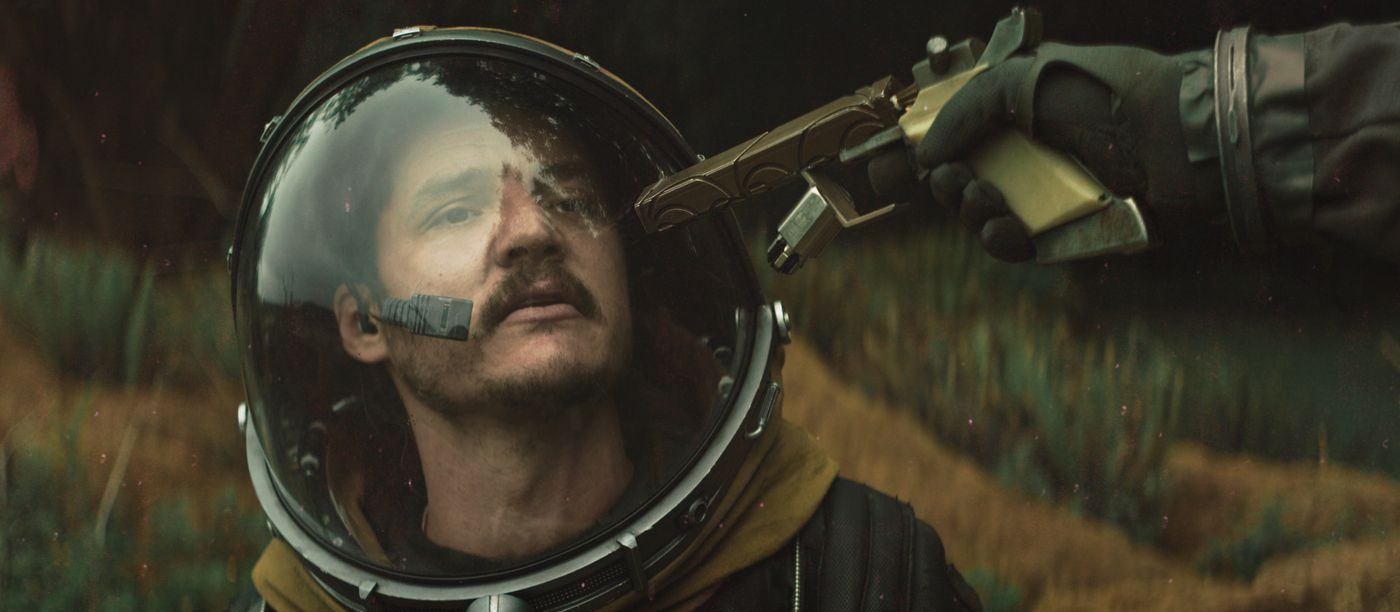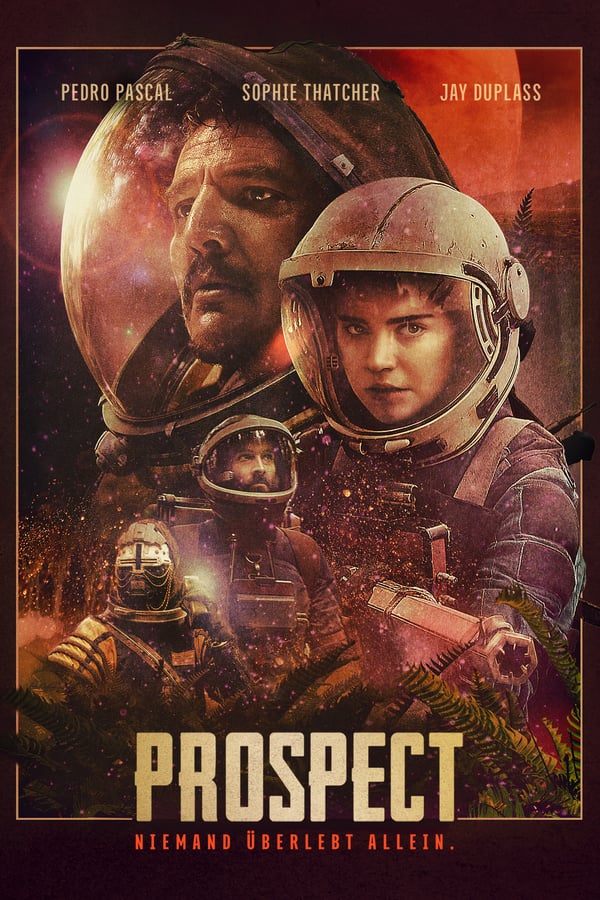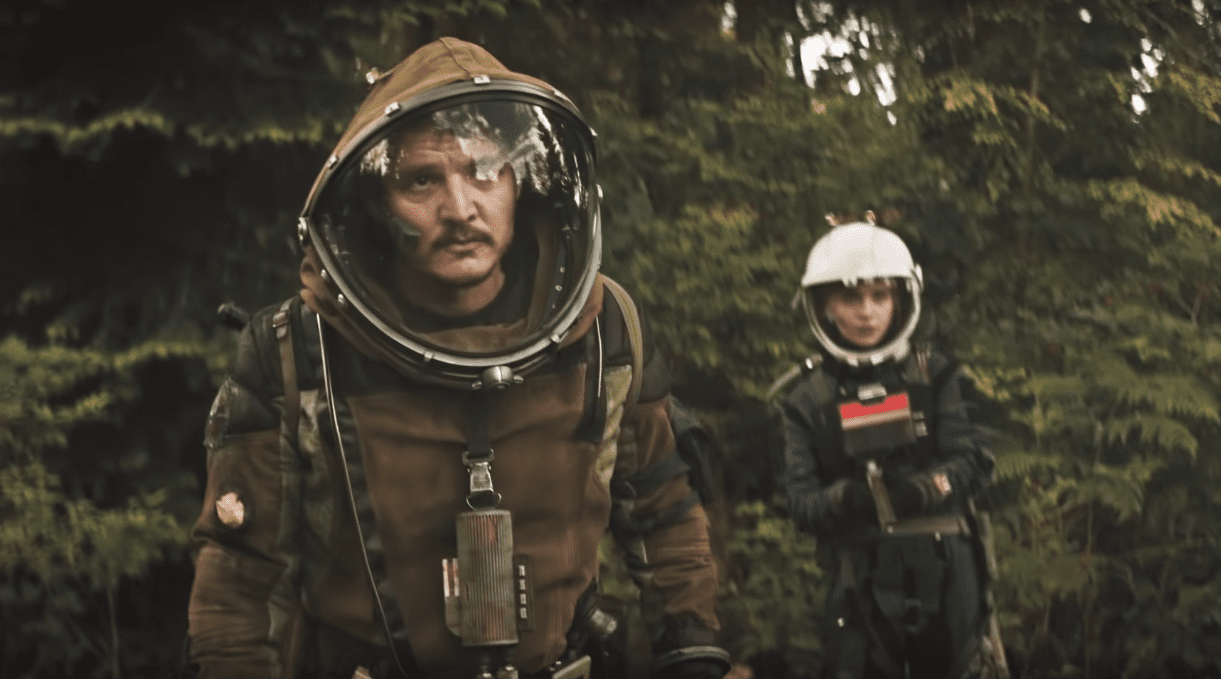

“It was all in the name of self preservation, birdie. It was nothing personal.”
Unless you want to count a few gigantic franchise films as space Westerns, there really aren’t that many of them in existence when it comes to cinema. Firefly and its theatrical finale Serenity fit the bill, but that show is almost twenty years old now. Enter Prospect, a modest enterprise that favors a grounded approach, efficiently achieving a tactile sci-fi aesthetic and shaping its story in Western archetypes. It cost a fraction of a tentpole genre film and yet equals or exceeds most of them in merit.
In their debut feature, co-writer/directors Zeek Earl and Chris Caldwell chose to focus their efforts in areas that standard blockbuster sci-fi films do not. There are few epic moments, a small roster of characters, and only subtle uses of CGI (otherwise there’s an insane dedication to practical effects). Instead of grandiose spectacle, the film is characterized by its rich dialogue, its expansive set design, and its excellent world-building. I like to add a disclaimer when I say that things were shot on a budget—so although Prospect cost several million dollars to make and so is not really low-budget, it is when you compare it to the blockbusters that it is competing with, genre-wise. That it is better than those films in many respects speaks to the ingenuity of its creators.
The stage is set for us by conversations between Cee (Sophie Thatcher) and her drug addict father Damon (Jay Duplass) aboard a space carrier. They intend to drop onto a forested moon to prospect for rare gems that are cut from the bowels of a poisonous immobile creature found beneath the moon’s surface. It’s a goldrush, basically; an opportunity ill-suited for a motherless teenage girl but one that Cee is resigned to.
A malfunction with their drop pod causes them to land a considerable distance from their intended location and precludes the possibility of getting off-planet by the means they arrived. Thus their journey starts in low spirits, but they soon find an old dig site and are able to procure a nice-sized gem that could fund a trip to their home planet. It is here that the practical effects make themselves readily apparent as Damon handles, cuts and sprays the hissing alien creature in order to get his hands on the gem without damaging it.

Soon after collecting their prize they encounter two rival prospectors. One of them, a menacing brute, wears a mask with a tinted visor and does not speak. The other is Ezra (Pedro Pascal), a jaded scalawag who points his gun at Cee’s father and forces the divestiture of all his belongings, including the gem. Cee springs from hiding and tries to save her father, but the ensuing shootout leaves only Cee and Ezra left standing.
The relationship that develops between the two in the wake of this event is one of distrust and unrelenting tension. Nevertheless, they come to an uneasy truce when they realize that their only shot at getting off-moon in one piece is together—they must pose as the father-daughter combo that is expected at the prospecting site.
Ezra is the film’s most fully realized character and Pascal inhabits him with natural suavity. He’s a conflicted mess of selfishness and compassion, his motives further muddled by his infected wounds. I’m sure some will find him over-written, as he speaks with a southern drawl and is given a mouthful of verbose lines quite frequently, but I found the performance to be very fun. He’s interesting, narratively-speaking, because he enters the film as a minor villain yet comes to be a primary protagonist. While he remains self-interested throughout—reminding me of the opportunistic, half-loyal characters of The Treasure of the Sierra Madre—his relationship with Cee evolves to a point where the two feel a legitimate if undefined obligation to one another.
The filmmakers wisely include several situations where one must come to the aid of the other, and thus each owes the other their life. The most harrowing situation occurs when they approach an isolationist tribe of villagers who live on the moon and practice an obscure religion, in hopes that they can provide a concoction to save Ezra’s infected arm. After they give it to him, he asks what they want as payment, and they offer him a case of gems. Uncomprehending, Ezra indicates that he does not understand. The leader of the group says, “For the girl.” It is then that we notice the corpse of the clan’s matriarch lying in the corner. Ezra pauses for just a moment, maybe considering how to talk his way out of it, maybe genuinely considering the offer, but Cee flees before his hand is forced.
Cee is mildly less developed, but Thatcher, who had never acted in a film before this as far as I can tell, does a bang up job with the material. It’s a tough predicament for the writer, positioning a character on a foreign planet, the closest thing to a companion being the man who just gunned down her own father. That Thatcher even gets us in the ballpark of believability is remarkable. But she does, with seeming ease, exuding a quiet determination that aligns her actions with her unwavering moral compass. Where Ezra is very talkative if not exactly honest, Cee is an inward-gazing character, with only a few moments of true openness where she reveals that she memorized and then rewrote and expanded her favorite book. Otherwise she is a child who must act like an adult—cutting through human flesh, handling weapons, etc. She’s a strong female character, for sure, and has a better arc than most of the hammy modern portrayals of superheroines.

Where Prospect loses some points is in its finale, where it essentially refuses to engage with the human side of its story. After so much focus on characters rather than plot, it is a shame that the final act is used almost exclusively to carry us through the mechanics of getting off the moon, neglecting to give Cee any time to deal with the traumatic events that she’s endured. It’s not that there needs to be some kind of meta-commentary about trauma or the loss of a loved one or whatever; but if you’re going to keep riddling your protagonist with haymakers you gotta let them have a moment to breathe at some point. Perhaps they thought the scene where she talked about her book was sufficient, but I think some closure concerning her father’s death would have gone a long way.
But I cannot deny that Earl and Caldwell have evident prowess in the arena of visual storytelling. Prospect effectively captures our attention in a way that the sweeping epics of hundred million dollar budgets do not. Since it doesn’t have any exploding planets, humanoid alien races, ancient lore, or galaxy-wide conflicts, none of that needs to take our headspace or time on screen. The needs are simple, and thus the personal story was shot almost entirely on-location with practical rather than digital effects. While the physical burden of hobbling around in the woods wearing bulky hodgepodge space suits surely wore on the cast, it provides a noticeably improved textural experience over a green screen film.
Earl and Caldwell have offered great insight regarding the use of special effects. They know their style is not exactly practical (in the general sense of the term), but the benefits far outweigh the drawbacks. They made 360° sets, had a firearms expert design plastic, 3-D printable guns, and layered footage of actual dust onto every scene rather than resort to CGI (check out the NoFilmSchool article at the end of the review). In terms of effort, their approach is clearly more intensive, but it’s a one-time payment for enduring rewards. I’m certain the level of effort put into some of this stuff was excessive, but the actor with a sore back will be happy in ten years when people are still talking about the film while having forgotten those where the extra mile was not traversed.
The commitment to a form of realism was carried into the screenplay, where the filmmakers refused to contrive situations simply to have expected moments. For instance, Thatcher and Pascal spend the majority of the film wearing their helmets, with only a few brief moments that fit into the story where they are without visors obscuring their faces. They are on a moon where the air is polluted by poisonous dust, you can’t just take your helmet off. (Compare with some lite sci-fi where the writers will, for instance, apply gravity in space if the story needs it, or use sound in space, etc.). It was that integrated approach to storytelling that ultimately gives Prospect its air of legitimacy.
Look, guys. Prospect cost $4M to make. And it’s very good. The Rise of Skywalker—a decent landing for the modern trilogy but a thoroughly lackluster film—cost $275M to make. That’s ~70x difference. I know it’s not as simple as this, but there’s a huge margin for error built in—let’s ditch nostalgia-mining franchises and instead of a new Star Wars make 70 films for every one of those cash-grabs that would have been made. Even if only 10% of them are this good, we still have many more great films as a result. Imagine if instead of a bloated space opera with familiar characters every year, instead we got a couple dozen of Moon, Primer, Coherence, I Am Mother, Cube. I know that’s not how things work, but one can dream.
Sources:
Fusco, Jon. “A Guide to DIY Production Design From the Team Behind ‘Prospect’”. NoFilmSchool. 7 November 2018.
Rougeau, Michael. “New Sci-Fi Movie Prospect’s Insane Dedication To Practical Effects”. Gamespot. 1 November 2018.